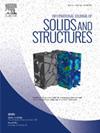梯度弹性壳的大变形
IF 3.4
3区 工程技术
Q1 MECHANICS
International Journal of Solids and Structures
Pub Date : 2025-06-20
DOI:10.1016/j.ijsolstr.2025.113507
引用次数: 0
摘要
基于Budiansky的非线性壳理论,给出了大变形条件下全非线性梯度壳理论的一致力学表达式。这项工作扩展了Piola微观-宏观识别程序,该程序基于Kirchhoff-Love假设框架内微观和宏观运动学量之间的对应关系。利用运动精确模型推导出弱形式的场方程,该模型以壳体中表面膜和弯曲应变及其协变导数表示。该公式保留了拉格朗日应变张量中的高阶项,从而能够全面地表示变形行为。引入了圣维南本构方程的扩展,以纳入内部材料长度尺度的影响。为适应应变梯度理论引入的附加自由度,设计了合适的有限元。为了证明所提出的公式在捕获大变形方面的能力,给出了涉及梯度微板的数值例子。结果表明,在小变形和大变形情况下,微尺度板的预测挠度都明显小于经典壳理论预测的挠度。本文章由计算机程序翻译,如有差异,请以英文原文为准。

Large deformations of gradient elastic shells
Based on Budiansky’s nonlinear shell theory, a consistent mechanical formulation for a fully nonlinear gradient shell theory in the large deformation regime is developed. This work extends the Piola micro-macro identification procedure, which is grounded in the correspondence between micro and macro kinematical quantities within the framework of the Kirchhoff–Love hypothesis. The field equations are derived in their weak forms using a kinematically exact model, expressed in terms of the shell mid-surface membrane and bending strains along with their covariant derivatives. This formulation retains higher-order terms in the Lagrangian strain tensor, enabling a comprehensive representation of the deformation behavior. An extension of the Saint-Venant constitutive equation is introduced to incorporate the influence of an internal material length scale. A suitable finite element is developed to accommodate the additional degrees of freedom introduced by the strain gradient theory. To demonstrate the capability of the proposed formulation in capturing large deformations, numerical examples involving gradient microplates are presented. The results show that the predicted deflections of micro-scale plates are significantly smaller than those predicted by classical shell theory in both small and large deformation regimes.
求助全文
通过发布文献求助,成功后即可免费获取论文全文。
去求助
来源期刊
CiteScore
6.70
自引率
8.30%
发文量
405
审稿时长
70 days
期刊介绍:
The International Journal of Solids and Structures has as its objective the publication and dissemination of original research in Mechanics of Solids and Structures as a field of Applied Science and Engineering. It fosters thus the exchange of ideas among workers in different parts of the world and also among workers who emphasize different aspects of the foundations and applications of the field.
Standing as it does at the cross-roads of Materials Science, Life Sciences, Mathematics, Physics and Engineering Design, the Mechanics of Solids and Structures is experiencing considerable growth as a result of recent technological advances. The Journal, by providing an international medium of communication, is encouraging this growth and is encompassing all aspects of the field from the more classical problems of structural analysis to mechanics of solids continually interacting with other media and including fracture, flow, wave propagation, heat transfer, thermal effects in solids, optimum design methods, model analysis, structural topology and numerical techniques. Interest extends to both inorganic and organic solids and structures.

 求助内容:
求助内容: 应助结果提醒方式:
应助结果提醒方式:


